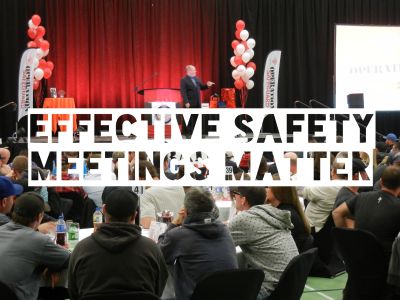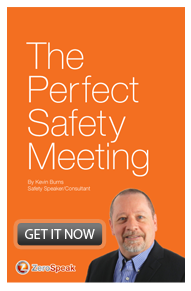There are requirements to cover in safety meetings. They require a balanced approach. Engagement and safety have to work together.
 No one has ever complained that the safety meeting was too short. In fact, cheers go up when the safety meeting somehow magically ends early. Safety meetings are the only legally required meetings of an organization besides the shareholders’ Annual General Meetings. But nowhere in the OH&S Act does it require safety meetings to be dull, dry, boring or long.
No one has ever complained that the safety meeting was too short. In fact, cheers go up when the safety meeting somehow magically ends early. Safety meetings are the only legally required meetings of an organization besides the shareholders’ Annual General Meetings. But nowhere in the OH&S Act does it require safety meetings to be dull, dry, boring or long.
This article addresses longer format meetings like safety days, stand-downs, or any other multi-hour safety event.
Safety meetings can either be effective or confusing. Yes, there are requirements to cover in the safety meeting but it has to be a balanced approach. Engagement and safety have to work together.
Here are three ways that you can shorten the length of the safety meeting and still be more effective at engaging your people:
1Think quality over quantity. Stop thinking in blocks of time and start thinking in blocks of workable information. Safety meetings utilizing several presenters can potentially address a multitude of topics. Senior managers may want to discuss new projects. Outside experts might be brought in to address working in heat. Whomever is presenting will want to know how much time they have to present and, “what time do I start?” This presents the first problem. A presenter scheduled to start at 10AM may only show up at 9:50AM. That means the earlier presenters will have to fill the two previous hours until the presenter arrives. The second problem occurs when you force presenters to fill their time slot. Do you really need to set aside 45 minutes to address ladder safety? Give a presenter a block of time and they will fill it. Even if they only have 15 minutes of solid information, the rest will be padding and filler. Every off-topic thought in a presentation competes against the important subject matter. Attendees are left to discern what was important from what was padding and filler. Oh, and if your presenter doesn’t want to attend the whole safety meeting awaiting their turn, do you really want them at your meeting?
2Identify the one thing you want to happen. If you are going to have a meeting, it needs to be focused on accomplishing one or two things only. Every speaker, presentation and PowerPoint slide should support the purpose of the meeting. Attendees should come away with a clear understanding of what you want them to do with the information you gave them in this meeting. It should address the issue or issues that they are either facing or about to face in their day-to-day work. That means you as the safety meeting organizer, have to work backwards. Determine what one or two things you want to have happen as a result of this meeting. What do you want your employees to do better or differently? Identify the one or two takeaways from the meeting and then ensure that every presentation speaks to those one or two issues only. The more ideas you introduce, the more you confuse the attendees. If the safety meeting isn’t clear on its intentions, how can you expect your people to be clear about what they’re supposed to do?
3Answer four questions. Every safety meeting attendee wants to know the answers to four questions. Answer these questions during your meeting planning. Help your meetings to become much more effective and laser-focused. Here are the four questions you need to answer:
- What is the purpose of this meeting? What is the theme, the point of having this meeting?
- What is it that we are about to learn? Give attendees some sense of the subject matter that is about to come at them.
- Why is it important? Inform meeting attendees why you have chosen this theme at this time and why it is important information at this time.
- What do you want us to do with the information? This is the takeaway point. Explain what you expect your people to be able to take away from the meeting and explain how you want them to apply it.
 They will engage better if they know the answers to these four questions. And, your presenters need these four questions answered before they prepare for their presentations.
They will engage better if they know the answers to these four questions. And, your presenters need these four questions answered before they prepare for their presentations.
There’s no law against reducing the amount of time presenters get at safety meetings. There are no minimums that you are required to fill. Shorten up the presentations to 10-15 minutes each. Identify the one or two things you want to have happen. And tell your people why they’re there, what they will learn and what you want them to do with the information. Your safety meetings will be laser-like and far more effective.
Kevin Burns gives engaging, entertaining and inspiring speeches to front-line employees at safety meetings. He also works with supervisors and safety managers on-site or in keynote presentations at conferences. Kevin helps organizations integrate caring for and valuing employees through their safety programs. Kevin Burns is a management consultant, safety speaker and author of 9 books.He is based in Calgary, Canada.
©2016 ZeroSpeak Corporation and Kevin Burns.
No part of this post may be reproduced without the expressed consent of the author.


